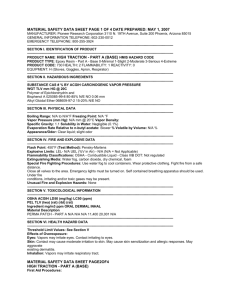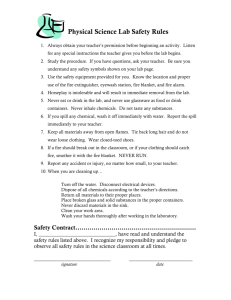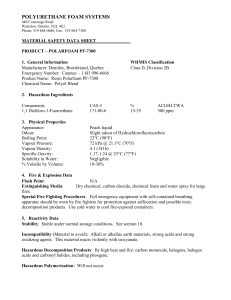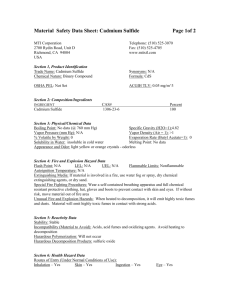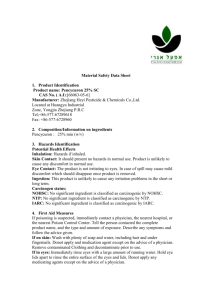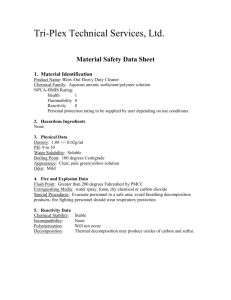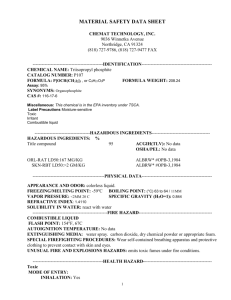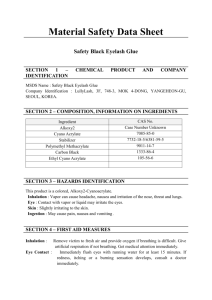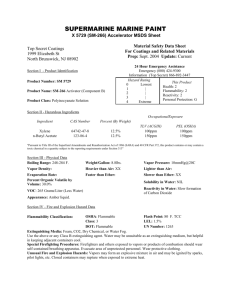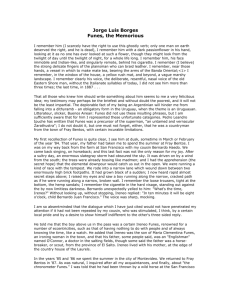high-traction-msds - Pioneer Research Corporation
advertisement
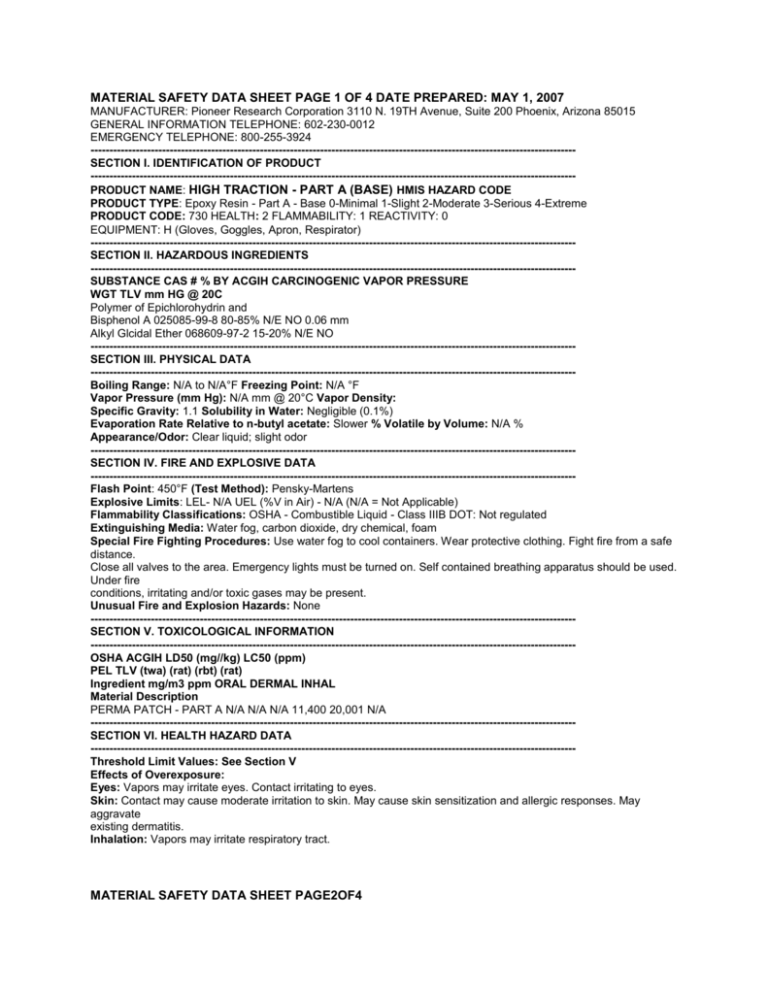
MATERIAL SAFETY DATA SHEET PAGE 1 OF 4 DATE PREPARED: MAY 1, 2007 MANUFACTURER: Pioneer Research Corporation 3110 N. 19TH Avenue, Suite 200 Phoenix, Arizona 85015 GENERAL INFORMATION TELEPHONE: 602-230-0012 EMERGENCY TELEPHONE: 800-255-3924 --------------------------------------------------------------------------------------------------------------------------------SECTION I. IDENTIFICATION OF PRODUCT --------------------------------------------------------------------------------------------------------------------------------PRODUCT NAME: HIGH TRACTION - PART A (BASE) HMIS HAZARD CODE PRODUCT TYPE: Epoxy Resin - Part A - Base 0-Minimal 1-Slight 2-Moderate 3-Serious 4-Extreme PRODUCT CODE: 730 HEALTH: 2 FLAMMABILITY: 1 REACTIVITY: 0 EQUIPMENT: H (Gloves, Goggles, Apron, Respirator) --------------------------------------------------------------------------------------------------------------------------------SECTION II. HAZARDOUS INGREDIENTS --------------------------------------------------------------------------------------------------------------------------------SUBSTANCE CAS # % BY ACGIH CARCINOGENIC VAPOR PRESSURE WGT TLV mm HG @ 20C Polymer of Epichlorohydrin and Bisphenol A 025085-99-8 80-85% N/E NO 0.06 mm Alkyl Glcidal Ether 068609-97-2 15-20% N/E NO --------------------------------------------------------------------------------------------------------------------------------SECTION III. PHYSICAL DATA --------------------------------------------------------------------------------------------------------------------------------Boiling Range: N/A to N/A°F Freezing Point: N/A °F Vapor Pressure (mm Hg): N/A mm @ 20°C Vapor Density: Specific Gravity: 1.1 Solubility in Water: Negligible (0.1%) Evaporation Rate Relative to n-butyl acetate: Slower % Volatile by Volume: N/A % Appearance/Odor: Clear liquid; slight odor --------------------------------------------------------------------------------------------------------------------------------SECTION IV. FIRE AND EXPLOSIVE DATA --------------------------------------------------------------------------------------------------------------------------------Flash Point: 450°F (Test Method): Pensky-Martens Explosive Limits: LEL- N/A UEL (%V in Air) - N/A (N/A = Not Applicable) Flammability Classifications: OSHA - Combustible Liquid - Class IIIB DOT: Not regulated Extinguishing Media: Water fog, carbon dioxide, dry chemical, foam Special Fire Fighting Procedures: Use water fog to cool containers. Wear protective clothing. Fight fire from a safe distance. Close all valves to the area. Emergency lights must be turned on. Self contained breathing apparatus should be used. Under fire conditions, irritating and/or toxic gases may be present. Unusual Fire and Explosion Hazards: None --------------------------------------------------------------------------------------------------------------------------------SECTION V. TOXICOLOGICAL INFORMATION --------------------------------------------------------------------------------------------------------------------------------OSHA ACGIH LD50 (mg//kg) LC50 (ppm) PEL TLV (twa) (rat) (rbt) (rat) Ingredient mg/m3 ppm ORAL DERMAL INHAL Material Description PERMA PATCH - PART A N/A N/A N/A 11,400 20,001 N/A --------------------------------------------------------------------------------------------------------------------------------SECTION VI. HEALTH HAZARD DATA --------------------------------------------------------------------------------------------------------------------------------Threshold Limit Values: See Section V Effects of Overexposure: Eyes: Vapors may irritate eyes. Contact irritating to eyes. Skin: Contact may cause moderate irritation to skin. May cause skin sensitization and allergic responses. May aggravate existing dermatitis. Inhalation: Vapors may irritate respiratory tract. MATERIAL SAFETY DATA SHEET PAGE2OF4 HIGH TRACTION - PART A (BASE) First Aid Procedures: Eyes: Immediately flush eyes with plenty of water for 15 minutes and consult a physician. Skin: Wash thoroughly with soap and water or waterless hand cleaners. Remove contaminated clothing and wash clothing before reuse. Inhalation: Remove person to fresh air. Apply artificial respiration, if necessary. If breathing is difficult, oxygen may be given. Ingestion: Drink large quantities of water immediately. Induce vomiting. Contact physician immediately. Never give anything to an unconscious person. ----------------------------------------------------------------------------------------------------------------------------------SECTION VIII. REACTIVITY DATA ----------------------------------------------------------------------------------------------------------------------------------Stability: Stable Stability Conditions to Avoid: None Material to Avoid: Strong oxidizing agents, mineral acids. Hazardous Decomposition:: Oxides of carbon, aldehydes. Toxic monomer fumes and/or short chain hydrocarbons. Hazardous Polymerization: Will not occur. Polymerization Conditions to Avoid: None ----------------------------------------------------------------------------------------------------------------------------------SECTION IX SPILL OR LEAK PROCEDURES ----------------------------------------------------------------------------------------------------------------------------------Spill Response: Absorb with sand and dispose of in an appproved manner. Dike area with sand to contain spilled liquid. Prevent spillage from entering underground water systems. Ventilate area. Flush area with water but do not flush to sewer. Remaining material may be emulsified with soap and water and absorbed Scoop up contaminated soil and place in dry drum. If transportation spill, call 1-800-255-3924. Large spills may be pumped into closed, but not sealed, containers. Product Disposal: Empty decontaminated containers should be crushed to prevent reuse. Dipose of in accordance with local environmental authorities. ----------------------------------------------------------------------------------------------------------------------------------SECTION X. SPECIAL PROTECTION INFORMATION ----------------------------------------------------------------------------------------------------------------------------------Respiratory Precaution: NESA/NIOSH approved respirator is highly recommended. Self-contained breathing apparatus in concentrations above PEL/TLV. Avoid breathing possible funes, mists and vapors which can cause severe repiratory damage. Always work in areas with adequate ventilation to allow dissipation of chemical fumes, and where applicable, solvent funes. Ventilation: Provide adequate cross air circulation. Protective Gloves: Gloves resistant to chemical penetration. Neoprene or rubber gloves. Eye Protection: Splashproof safety, chemical worker or chemical splash goggles. Other: Eyewash station, emergency shower. Use of Barrier Cream recommended. Chemical apron, rubber foot covering. Clean long sleeve and leg clothing. ----------------------------------------------------------------------------------------------------------------------------------SECTION XI. SPECIAL PRECAUTIONS ----------------------------------------------------------------------------------------------------------------------------------Precautions to be Taken in Handling and Storage: Store in a cool dry place. Keep away from open flames. Store in tightly closed containers. Store away from food and beverages. Wash thoroughly after handling. Wash before eating, drinking, smoking or using toilet. Other Precautions: Check all containers for leaks. Avoid prolonged breathing or contact with skin. KEEP OUT OF REACH OF CHILDREN Proprietary ingredient - may be made available as provided in 29 CFR 1910.1200 (I). All our proprietary materials are on file with New Jersey Department of Health and the EIN number is provided. ----------------------------------------------------------------------------------------------------------------------------------REPORTABLE UNDER SARA TITLE III Chemical: Epichlorchydrin CAS#: 106-89-8 Percent: 3ppm Sections: 313 302 304 TPQ(#) RQ(#) Y 1000 1000 MATERIAL SAFETY DATA SHEET PAGE2OF4 HIGH TRACTION - PART A (BASE) First Aid Procedures: Eyes: Immediately flush eyes with plenty of water for 15 minutes and consult a physician. Skin: Wash thoroughly with soap and water or waterless hand cleaners. Remove contaminated clothing and wash clothing before reuse. Inhalation: Remove person to fresh air. Apply artificial respiration, if necessary. If breathing is difficult, oxygen may be given. Ingestion: Drink large quantities of water immediately. Induce vomiting. Contact physician immediately. Never give anything to an unconscious person. ----------------------------------------------------------------------------------------------------------------------------------SECTION VIII. REACTIVITY DATA ----------------------------------------------------------------------------------------------------------------------------------Stability: Stable Stability Conditions to Avoid: None Material to Avoid: Strong oxidizing agents, mineral acids. Hazardous Decomposition:: Oxides of carbon, aldehydes. Toxic monomer fumes and/or short chain hydrocarbons. Hazardous Polymerization: Will not occur. Polymerization Conditions to Avoid: None ----------------------------------------------------------------------------------------------------------------------------------SECTION IX SPILL OR LEAK PROCEDURES ----------------------------------------------------------------------------------------------------------------------------------Spill Response: Absorb with sand and dispose of in an appproved manner. Dike area with sand to contain spilled liquid. Prevent spillage from entering underground water systems. Ventilate area. Flush area with water but do not flush to sewer. Remaining material may be emulsified with soap and water and absorbed Scoop up contaminated soil and place in dry drum. If transportation spill, call 1-800-255-3924. Large spills may be pumped into closed, but not sealed, containers. Product Disposal: Empty decontaminated containers should be crushed to prevent reuse. Dipose of in accordance with local environmental authorities. ----------------------------------------------------------------------------------------------------------------------------------SECTION X. SPECIAL PROTECTION INFORMATION ----------------------------------------------------------------------------------------------------------------------------------Respiratory Precaution: NESA/NIOSH approved respirator is highly recommended. Self-contained breathing apparatus in concentrations above PEL/TLV. Avoid breathing possible funes, mists and vapors which can cause severe repiratory damage. Always work in areas with adequate ventilation to allow dissipation of chemical fumes, and where applicable, solvent funes. Ventilation: Provide adequate cross air circulation. Protective Gloves: Gloves resistant to chemical penetration. Neoprene or rubber gloves. Eye Protection: Splashproof safety, chemical worker or chemical splash goggles. Other: Eyewash station, emergency shower. Use of Barrier Cream recommended. Chemical apron, rubber foot covering. Clean long sleeve and leg clothing. ----------------------------------------------------------------------------------------------------------------------------------SECTION XI. SPECIAL PRECAUTIONS ----------------------------------------------------------------------------------------------------------------------------------Precautions to be Taken in Handling and Storage: Store in a cool dry place. Keep away from open flames. Store in tightly closed containers. Store away from food and beverages. Wash thoroughly after handling. Wash before eating, drinking, smoking or using toilet. Other Precautions: Check all containers for leaks. Avoid prolonged breathing or contact with skin. KEEP OUT OF REACH OF CHILDREN Proprietary ingredient - may be made available as provided in 29 CFR 1910.1200 (I). All our proprietary materials are on file with New Jersey Department of Health and the EIN number is provided. ----------------------------------------------------------------------------------------------------------------------------------REPORTABLE UNDER SARA TITLE III Chemical: Epichlorchydrin CAS#: 106-89-8 Percent: 3ppm Sections: 313 302 304 TPQ(#) RQ(#) Y 1000 1000 MATERIAL SAFETY DATA SHEET PAGE 3 OF 4 DATE PREPARED: MAY 1, 2007 MANUFACTURER: Pioneer Research Corporation 3110 N. 19TH Avenue, Suite 200 Phoenix, Arizona 85015 GENERAL INFORMATION TELEPHONE: 602-230-0012 EMERGENCY TELEPHONE: 800-255-3924 ------------------------------------------------------------------------------------------------------------------------------------SECTION I. IDENTIFICATION OF PRODUCT ------------------------------------------------------------------------------------------------------------------------------------PRODUCT NAME: HIGH TRACTION - PART B (REACTOR) HMIS HAZARD CODE PRODUCT TYPE: Epoxy Curing Agent 0-Minimal 1-Slight 2-Moderate 3-Serious 4-Extreme PRODUCT CODE: 730 HEALTH: 3 FLAMMABILITY: 1 REACTIVITY: 0 EQUIPMENT: H (Gloves, Goggles, Apron, Respirator) ------------------------------------------------------------------------------------------------------------------------------------SECTION II. HAZARDOUS INGREDIENTS ------------------------------------------------------------------------------------------------------------------------------------SUBSTANCE CAS # % BY ACGIH CARCINOGENIC VAPOR PRESSURE WEIGHT TLV mm HG @ 20C Tofa, Reaction Products w/Tepa 68953-36-6 >52% N/E NO 1.0 Diethylenetriamine 111-40-0 >10% 1 NO .99 Tetraethylenepentamine 112-57-2 >10% N/E NO N/E Phenol, Nonyl 84852-15-3 >20% N/E NO >1 Bisphenol A 080-005-7 <4% 1.4 NO N/E (N/E = Not Established) ------------------------------------------------------------------------------------------------------------------------------------SECTION III. PHYSICAL DATA ------------------------------------------------------------------------------------------------------------------------------------Boiling Range: N/A to N/A°F Freezing Point: N/A °F Vapor Pressure (mm Hg): 0.9mm @ 20°C Vapor Density: 7.59 (Heavier than air) Specific Gravity: 0.98 Solubility in Water: Negligible (0.1%) Evaporation Rate Relative to n-butyl acetate: Slower % Volatile by Volume: N/A % Appearance/Odor: Amber liquid; amine odor ------------------------------------------------------------------------------------------------------------------------------------SECTION IV. FIRE AND EXPLOSIVE DATA ------------------------------------------------------------------------------------------------------------------------------------Flash Point: 250°F (Test Method): Pensky-Martens Explosive Limits: LEL- 1.4 UEL (%V in Air) - N/A (N/A = Not Applicable) Flammability Classifications: OSHA - Combustible Liquid - Class IIIB DOT: Not regulated Extinguishing Media: Water fog, carbon dioxide, dry chemical, foam, alcohol foam. Special Fire Fighting Procedures: Use water fog to cool containers. Wear protective clothing. Fight fire from a safe distance. Close all valves to the area. Emergency lights must be turned on. Self contained breathing apparatus should be used. Do not spray pool fires directly. Under fire conditions, irritating and/or toxic gases may be present. Combustion products may be toxic. Unusual Fire and Explosion Hazards: None ------------------------------------------------------------------------------------------------------------------------------------SECTION V. TOXICOLOGICAL INFORMATION ------------------------------------------------------------------------------------------------------------------------------------OSHA ACGIH LD50 (mg//kg) LC50 (ppm) PEL TLV (twa) (rat) (rbt) (rat) Ingredient mg/m3 ppm ORAL DERMAL INHAL Material Description PERMA PATCH - PART B N/A N/A N/A 3990 1500 N/A MATERIAL SAFETY DATA SHEET PAGE 4 OF 4 HIGH TRACTION - PART B (REACTOR) ------------------------------------------------------------------------------------------------------------------------------------SECTION VI. HEALTH HAZARD DATA ------------------------------------------------------------------------------------------------------------------------------------Threshold Limit Values: See Section V Effects of Overexposure: Eyes: Vapors may irritate eyes. Contact irritating to eyes. May cause blindness or permanent eye injury. May cause severe eye burns. Corneal damage can occur and injury is slow to heal, if not treated. Skin: Skin may become dry. May cause skin sensitization and other allergic responses. Severe skin irritation may occur. May cause severe skin burns. Harmful if absorbed through skin. Inhalation: Vapors may irritate respiratory tract. If liquid is heated, avoid breathing vapors. Ingestion: Harmful if swallowed. First Aid Procedures: Eyes: Consult a physician immediately. Skin: Wash thoroughly with soap and water or waterless hand cleaners. Remove contaminated clothing and wash clothing before reuse. Contact physician immediately. Inhalation: Remove person to fresh air. Apply artificial respiration, if necessary. Contact physician immediately. Ingestion: Do not induce vomiting. Contact physician immediately. Never give anything to an unconscious person. ------------------------------------------------------------------------------------------------------------------------------------SECTION VIII. REACTIVITY DATA ------------------------------------------------------------------------------------------------------------------------------------Stability: Stable Stability Conditions to Avoid: None Material to Avoid: Strong oxidizing agents, mineral acids. Hazardous Decomposition:: Oxides of carbon, aldehydes. Toxic monomer fumes and/or short chain hydrocarbons. Hazardous Polymerization: Will not occur. Polymerization Conditions to Avoid: None ------------------------------------------------------------------------------------------------------------------------------------SECTION IX SPILL OR LEAK PROCEDURES ------------------------------------------------------------------------------------------------------------------------------------Spill Response: Absorb with sand and dispose of in an appproved manner. Dike area with sand to contain spilled liquid. Prevent spillage from entering underground water systems. Ventilate area. Flush area with water but do not flush to sewer. Remaining material may be emulsified with soap and water and absorbed Scoop up contaminated soil and place in dry drum. If transportation spill, call 1-800-255-3924. Large spills may be pumped into closed, but not sealed, containers. Product Disposal: Incinerate in approved manner. Dipose of in accordance with local environmental authorities. ------------------------------------------------------------------------------------------------------------------------------------SECTION X. SPECIAL PROTECTION INFORMATION ------------------------------------------------------------------------------------------------------------------------------------Respiratory Precaution: NESA/NIOSH approved respirator is highly recommended. Self-contained breathing apparatus in concentrations above PEL/TLV. Avoid breathing possible funes, mists and vapors which can cause severe repiratory damage. Always work in areas with adequate ventilation to allow dissipation of chemical fumes, and where applicable, solvent funes. Ventilation: Provide adequate cross air circulation. Exhaust at point of use. Mechanical in confined areas. Protective Gloves: Gloves resistant to chemical penetration. Neoprene or rubber gloves. Eye Protection: Splashproof safety, chemical worker or chemical splash goggles. Other: Eyewash station, emergency shower. Use of Barrier Cream recommended. Chemical apron, rubber foot covering. Clean long sleeve and leg clothing. ------------------------------------------------------------------------------------------------------------------------------------SECTION XI. SPECIAL PRECAUTIONS ------------------------------------------------------------------------------------------------------------------------------------Precautions to be Taken in Handling and Storage: Protect from freezing. Overheating may cause container to rupture. Store in a cool, dry place. Keep away from open flames. Keep container closed when not in use. Store in tighty closed containers. Store away from food and beverages. Store in a dry, well ventilated areas. Wash thoroughly after handling. Wash before eating, drinking, smoking or using toilet. Other Precautions: Check all containers for leaks. Wear protective clothing as in Section IX. Avoid prolonged breathing or contact with skin. KEEP OUT OF REACH OF CHILDREN Proprietary ingredient - may be made available as provided in 29 CFR 1910.1200 (I). All our proprietary materials are on file with New Jersey Department of Health and the EIN number is provided.
